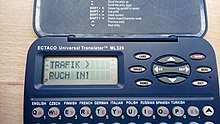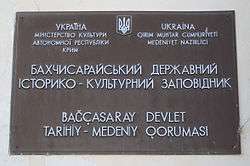Dotted and dotless I
Dotted İi and dotless Iı are separate letters in Turkish, Azerbaijani, Kazakh and other Latin alphabets of several Turkic languages. It is also part of the common Turkic Alphabet.

The dotless I, I ı, usually denotes the close back unrounded vowel sound (/ɯ/). Neither the upper nor the lower case version has a dot.
The dotted İ, İ i, usually denotes the close front unrounded vowel sound (/i/). Both the upper and lower case versions have a dot.
Examples:
- İstanbul /isˈtanbuɫ/ is the Turkish spelling for Istanbul. It starts with an i sound in standard dialect of Turkish, not an ı.
- Diyarbakır /diˈjaɾbakɯɾ/ is the Turkish spelling for Diyarbakır. In Turkish the first and last vowels are spelled and pronounced differently.
- Bakı /bɑˈcɯ/ is the Azerbaijani spelling for Baku.
In contrast, the letter j does not have this distinction in these languages, with a dot only on the lower case character: J j, but the dotless j does exist in Unicode: ȷ. That letter is sometimes used in mathematics with a combining hat to indicate a unit vector.
In scholarly writing on Turkic languages, ï is sometimes used for /ɯ/.[1]
Implications for ligature use

In some fonts, if the lowercase letters fi are placed adjacently, the dot-like upper end of the f would fall inconveniently close to the dot of the i, and therefore a ligature glyph is provided with the top of the f extended to serve as the dot of the i. A similar ligature for ffi is also possible. Since the forms without ligatures are unattractive and the ligatures make the i dotless, such fonts are not appropriate for use in a Turkish setting. However, the fi ligatures of some fonts do not merge the letters and instead space them next to each other, with the dot on the i remaining. Such fonts are appropriate for Turkish, but the writer must be careful to be consistent in the use of ligatures.
In computing
| Preview | I | i | İ | ı | ||||
|---|---|---|---|---|---|---|---|---|
| Unicode name | LATIN CAPITAL LETTER I | LATIN SMALL LETTER I | LATIN CAPITAL LETTER I WITH DOT ABOVE | LATIN SMALL LETTER DOTLESS I | ||||
| Encodings | decimal | hex | decimal | hex | decimal | hex | decimal | hex |
| Unicode | 73 | U+0049 | 105 | U+0069 | 304 | U+0130 | 305 | U+0131 |
| UTF-8 | 73 | 49 | 105 | 69 | 196 176 | C4 B0 | 196 177 | C4 B1 |
| Numeric character reference | I | I | i | i | İ | İ | ı | ı |
| Named character reference | İ | ı, ı | ||||||
| ISO 8859-9 | 73 | 49 | 105 | 69 | 221 | DD | 253 | FD |
| ISO 8859-3 | 73 | 49 | 105 | 69 | 169 | A9 | 185 | B9 |
In normal typography, when lower case i is combined with other diacritics, the dot is generally removed before the diacritic is added; however, Unicode still lists the equivalent combining sequences as including the dotted i, since logically it is the normal dotted i character that is being modified.
Most Unicode software uppercases ı to I and lowercases İ to i, but, unless specifically configured for Turkish, it lowercases I to i and uppercases i to I. Thus uppercasing then lowercasing, or vice versa, changes the letters.
In the Microsoft Windows SDK, beginning with Windows Vista, several relevant functions have a NORM_LINGUISTIC_CASING flag, to indicate that for Turkish and Azerbaijani locales, I should map to ı and i to İ.
In the LaTeX typesetting language the dotless ı can be written with the backslash-i command: \i. The İ can be written using the normal accenting method (i.e. \.{I}).
Dotless ı (and dotted capital İ) is handled problematically in the Turkish locales of several software packages, including Oracle DBMS, PHP, Java (software platform),[2][3] and Unixware 7, where implicit capitalization of names of keywords, variables, and tables has effects not foreseen by the application developers. The C or US English locales do not have these problems. The .NET Framework has special provisions to handle the 'Turkish i'.[4]
Many cellphones available in Turkey (as of 2008) lacked a proper localization, which led to replacing ı by i in SMS, sometimes severely distorting the sense of a text. In one instance, a miscommunication played a role in the deaths of Emine and Ramazan Çalçoban in 2008.[5][6] A common substitution is to use the character 1 for dotless ı. This is also common in Azerbaijan (see also translit), but the meaning of words is generally understood.
John Cowan proposed disunification of plain Ii and capital letter dotless I and small letter I with dot above to make the casing more consistent.[7] The Unicode Technical Committee had previously rejected a similar proposal[8] because it would corrupt mapping from character sets with dotted and dotless I and corrupt data in these languages.

In some Ectaco translators, the letter İ was also treated as I (e.g. TRAFIK ⟨traffic⟩, when it's normally TRAFİK).
Usage in other languages

Dotted and dotless i are used in several other writing systems for Turkic languages:
- Azerbaijani: The Azerbaijani Latin alphabet used in Azerbaijan is modeled after Turkish since 1991.
- Karakalpak: The official Karakalpak alphabet approved in 2016 uses ⟨ı⟩ as the lowercase form of ⟨Í⟩.
- Kazakh: The 2018 Latin orthography uses dotless I to represent [j] and also to represent [i] in Russian loanwords, contrary to the letter's use in other Turkic languages. A Turkish-style alphabet, however, is used by linguists, the Kazakh Wikipedia (in addition to Cyrillic and Arabic) and the Kazakh diaspora in the West and Turkey. Dotted I in the Kazakh orthography represents [i] in native Kazakh words - its capital form was still dotless until 2019. In the original 2017 proposal, /j/ and (in Russian loanwords) /i/ were represented by the sequence i'. [/ə/], represented by dotless I in most Turkic orthographies, is instead represented by y. In 2019, under president Tokayev's suggestion, the upper-case İ was also introduced, to finalize replacing of upper-case Cyrillic І which mostly represents [ɪ].
- Volga Tatar: The Tatar alphabet in Russia is officially Cyrillic due to the requirements of Russian federal law. Several Romanization schemes exist, which are used on the Internet and some printed publication. Most of them are modelled in different ways on Turkish and employ dotted and dotless I, while some also use I with acute (Í), although for different phonemes. The only Latin alphabet that ever had official status in Tatarstan, Yañalif, used the character Ь instead of dotless i.
- Crimean Tatar: Cyrillic script is officially used for Crimean Tatar in the Autonomous Republic of Crimea. The Latin alphabet, which includes both dotted and dotless I, is still used, but is not the official script for the language.
The dotless ı may also be used as a stylistic variant of the dotted i, without there being any meaningful difference between them. This is common in Irish, for example. See Tittle.
Both the dotted and dotless I can be used in transcriptions of Rusyn to allow distinguishing between the letters Ы and И, which would otherwise be both transcribed as "y", despite representing different phonemes. Under such transcription the dotted İ would represent the Cyrillic І, and the dotless I would represent either Ы or И, with the other being represented by "Y".
See also
- African reference alphabet, where a similar situation occurs, albeit with the serifs rather than the tittles
- Tittle: the dot above "i" and "j" in most of the Latin scripts
- Yery (ы) — a letter used to represent [ɯ] in Turkic languages with Cyrillic script, and the similar [ɨ] in Russian
- I with bowl
Notes
- Marcel Erdal, A Grammar of Old Turkic, Handbook of Oriental Studies 3, ISBN 9004102949, 2004, p. 52
- "Turkish Java needs special brewing". Archived from the original on 2017-07-26. Retrieved 2008-09-12.
- The Policeman’s Horror: Default Locales, Default Charsets, and Default Timezones
- MSDN: Writing Culture-Safe Managed Code: The Turkish Example
- Diaz, Jesus (2008-04-21). "A cellphone's missing dot kills two people, puts three more in jail". Gizmodo. Retrieved 2015-08-28. The use of "i" resulted in an SMS with a completely twisted meaning: instead of writing the word "sıkışınca" it looked like he wrote "sikişince". Ramazan wanted to write "You change the topic every time you run out of arguments" (sounds familiar enough) but what Emine read was, "You change the topic every time they are fucking you" (sounds familiar too.)
- Orion, Egan (2008-04-26). "Cellphone localisation glitch turned deadly in Turkey – dotted i leads to tragedy]". The Inquirer. Archived from the original on 2020-01-02. Retrieved 2015-08-28.
- Cowan, John (September 10, 1997). "Resolving dotted and dotless "i"". unicode@unicode.org (Mailing list).
- Davis, Mark (September 11, 1997). "Re: Resolving dotted and dotless "i"". unicode@unicode.org (Mailing list).
References
- http://www.unicode.org/charts/PDF/U0100.pdf
- Tex Texin, Internationalization for Turkish: Dotted and Dotless Letter "I", accessed 15 Nov 2005